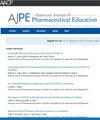介绍纵向跨专业教育计划和首届学生的成果。
IF 3.8
4区 教育学
Q1 EDUCATION, SCIENTIFIC DISCIPLINES
引用次数: 0
摘要
目的:描述一所药学院的纵向跨专业教育(IPE)计划,包括首届学生的成果:描述一所药学院(SOP)的纵向专业间教育(IPE)计划,包括首届学生的学习成果:2016 年的标准促使威斯康星大学麦迪逊分校成立了一个 IPE 特别工作组,负责制定和实施一项 IPE 计划,其中包括基于成果的目标、精心设计和正式的评估策略--这种方法得到了卫生职业认证合作组织的全国共识指导。从 2022 届毕业生开始,在四年制药学博士(PharmD)课程中纵向嵌入了所需的跨专业学习活动,包括基于课堂、模拟和临床的 IPE 活动。学生的学习成果主要集中在态度、技能和行为上,采用三种经过验证的自我报告方法进行纵向评估,以便进行前后比较--学生对跨专业临床教育的看法--修订版 2 (SPICE-R2)、专业间教育协作能力自我评估工具第 3 版 (IPEC-3) 和专业间协作能力达成情况调查-修订版 (ICCAS-R),再加上个人团队合作观察和反馈工具 (iTOFT)。结果:终点 SPICE-R2 和 IPEC-3 的平均得分在 "同意 "到 "非常同意 "的范围内,80%(4/5)的子量表的前后变化具有统计学意义。高级药学实践经验(APPE)学生的 ICCAS-R 评分和 APPE 学生在 iTOFT 上的普遍满意度评分的前后变化具有统计学意义,证明了学生达到并展示了积极的团队合作行为:结论:在四年制药学博士课程中实施了一项循序渐进的纵向 IPE 计划。首届学生队列评估结果表明,学生已为毕业后的跨专业实践做好了准备。本文章由计算机程序翻译,如有差异,请以英文原文为准。
Description of a Longitudinal Interprofessional Education Plan and Outcomes From an Inaugural Student Cohort
Objective
To describe a longitudinal interprofessional education (IPE) plan at 1 school of pharmacy including inaugural student cohort outcomes.
Methods
Standards 2016 prompted the creation of an IPE task force at the University of Wisconsin–Madison School of Pharmacy to develop and implement an IPE plan consisting of outcome-based goals, a deliberate design, and a formalized assessment strategy (an approach that inspired national consensus guidance from the Health Professions Accreditors Collaborative). Beginning with the 2022 graduating class, required interprofessional learning activities were embedded longitudinally across a 4-year Doctor of Pharmacy program and included classroom-, simulation-, and clinical-based IPE activities. Student learning outcomes, focused on attitudes, skills, and behaviors, were assessed longitudinally using 3 self-reported, validated measures allowing before and after comparisons: Student Perceptions of Interprofessional Clinical Education–Revised, Version 2, Interprofessional Education Collaborative Competency Self-Assessment Tool, Version 3, and Interprofessional Collaborative Competencies Attainment Survey–Revised, coupled with the Individual Teamwork Observation and Feedback Tool.
Results
End point Student Perceptions of Interprofessional Clinical Education–Revised, Version 2 and Interprofessional Education Collaborative Competency Self-Assessment Tool, Version 3 average scores were in the agree to strongly agree range with statistically significant before and after change in 80% (4 of 5) of subscales. Students’ attainment and demonstration of positive teamwork behaviors were evidenced by statistically significant before and after changes in advanced pharmacy practice experience student Interprofessional Collaborative Competencies Attainment Survey–Revised scores and universal satisfactory ratings of advanced pharmacy practice experience students on the Individual Teamwork Observation and Feedback Tool.
Conclusion
A developmentally progressive, longitudinal IPE plan was implemented into a 4-year Doctor of Pharmacy program. Inaugural student cohort assessment results documented students were prepared for interprofessional practice upon graduation.
求助全文
通过发布文献求助,成功后即可免费获取论文全文。
去求助
来源期刊
CiteScore
4.30
自引率
15.20%
发文量
114
期刊介绍:
The Journal accepts unsolicited manuscripts that have not been published and are not under consideration for publication elsewhere. The Journal only considers material related to pharmaceutical education for publication. Authors must prepare manuscripts to conform to the Journal style (Author Instructions). All manuscripts are subject to peer review and approval by the editor prior to acceptance for publication. Reviewers are assigned by the editor with the advice of the editorial board as needed. Manuscripts are submitted and processed online (Submit a Manuscript) using Editorial Manager, an online manuscript tracking system that facilitates communication between the editorial office, editor, associate editors, reviewers, and authors.
After a manuscript is accepted, it is scheduled for publication in an upcoming issue of the Journal. All manuscripts are formatted and copyedited, and returned to the author for review and approval of the changes. Approximately 2 weeks prior to publication, the author receives an electronic proof of the article for final review and approval. Authors are not assessed page charges for publication.

 求助内容:
求助内容: 应助结果提醒方式:
应助结果提醒方式:


